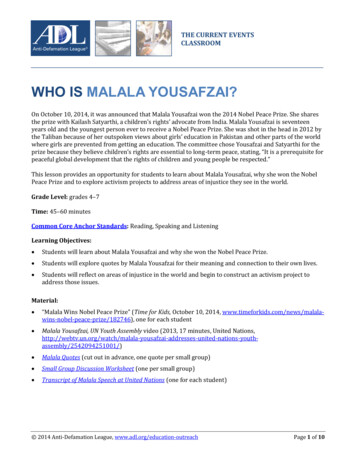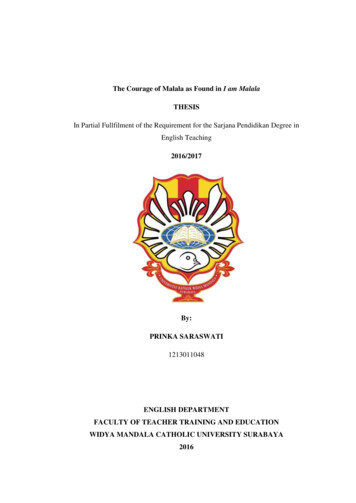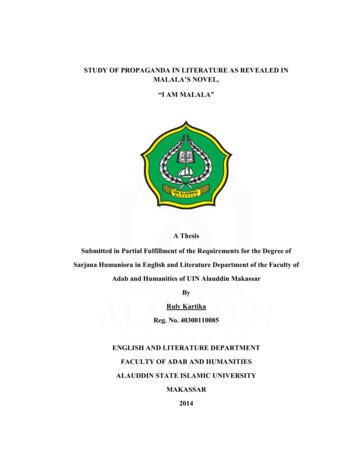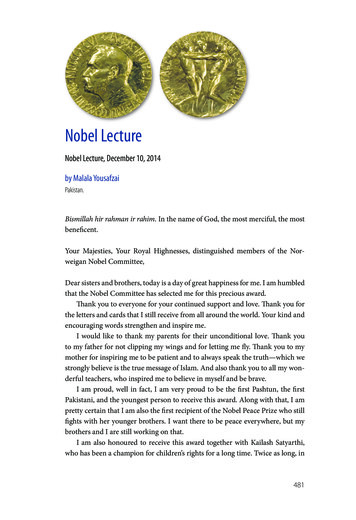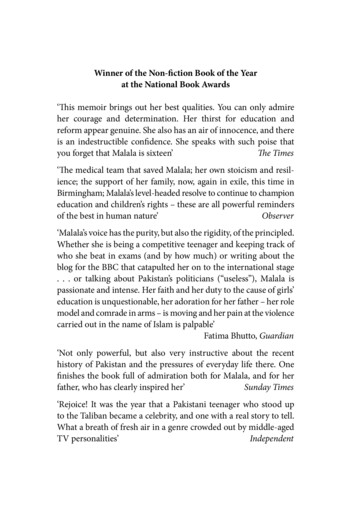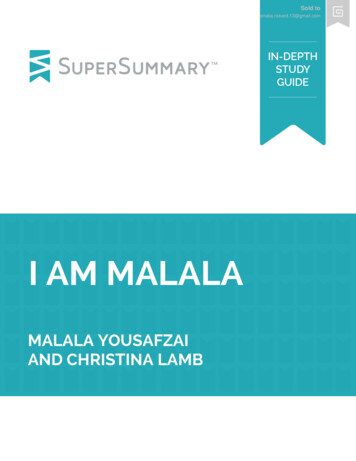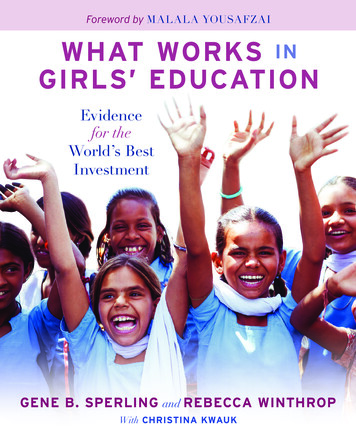
Transcription
Foreword by Malala YousafzaiWhat Works inGirls’ EducationEvidencefor theWorld’s BestInvestmentGEnE B. spErlinG and rEBEcca WinthropWith christina kWauk
What Works in Girls Education-FINAL.indd 19/18/15 9:13 AM
What Works in Girls Education-FINAL.indd 29/18/15 9:13 AM
What Works in Girls Education-FINAL.indd 39/18/15 9:13 AM
Copyright 2016THE BROOKINGS INSTITUTION1775 Massachusetts Avenue, N.W., Washington, D.C. 20036www.brookings.eduAll rights reserved. No part of this publication may be reproduced or transmitted in any form or by any meanswithout permission in writing from the Brookings Institution Press.The Brookings Institution is a private nonprofit organization devoted to research, education, and publicationon important issues of domestic and foreign policy. Its principal purpose is to bring the highest quality independent research and analysis to bear on current and emerging policy problems. Interpretations or conclusions in Brookings publications should be understood to be solely those of the authors.Library of Congress Cataloging-in-Publication data is available.978-0-8157-2860-3 (pbk. : alk. paper)978-0-8157-2861-0 (epub)978-0-8157-2862-7 (pdf)987654321Design and Composition by Chris KrupinskiWhat Works in Girls Education-FINAL.indd 49/18/15 9:13 AM
To our mothersTo Doris Sperling, for 50 years as an education pioneerfor equity and for assessing and teaching every child asan individual, for founding the Family Learning Institute,for improving the lives of countless students, and for beinga hero to her children, grandchildren, and husband.To Kathryn Winthrop, for loving, supporting, and empoweringher daughters; for being a role model, showing that it is nevertoo late to pursue your dreams and that success is possible asa woman in a man’s world; and for making the world abetter place through her preservation of our cultural heritage.What Works in Girls Education-FINAL.indd 59/18/15 9:13 AM
What Works in Girls Education-FINAL.indd 69/18/15 9:13 AM
CONTENTSxvxviiFOREWORD1CHAPTER 1. INTRODUCTIONACKNOWLEDGMENTSThe Power of Evidence and Girls’ Education. 4“Especially Girls”: Never Forgetting the Boys. 4Girls’ Education: Progress and Crisis. 6A Commitment to the Evidence on What Works. 7Five Compelling Challenges. 81. Quality Learning. 92. Reducing Violence Against Girls and Helping GirlsLearn, Even in Conflicts and Emergencies.103. Secondary Education and Adolescent Girls.114. Transitions from School to Work.125. Empowering Girls to Lead.12The Positive Generational Cycle of Girls’ Education.1315 CHAPTER 2. THE WORLD’S BEST INVESTMENT: GIRLS’EDUCATION1. Increases Economic Growth.19Evidence Continues to Mount That Increases inGirls’ Education Have a Positive Impact on aDeveloping Nation’s Growth.20The Quality of Schooling Is Closely Associated withEconomic Growth.21Increased Female Education Increases Agricultural Productivity.222. Leads to Better Wages and Jobs for Women.24Education Increases Women’s Wages.25Education Helps Women Get Better Jobs and Reduce Ratesof Vulnerable Employment.273. Saves the Lives of Children and Mothers.29Children’s Lives Are Saved When Mothers Have aBetter Education.29Increased Women’s Education Lowers Maternal Mortality.33What Works in Girls Education-FINAL.indd 79/18/15 9:13 AM
4. Leads to Smaller and More Sustainable Families.355. Results in Healthier and Better-Educated Children. 38Mothers’ Education Reduces Malnutrition and Stunting. 38Mothers’ Education Improves Children’s Health andImmunization Rate. 40Mothers’ Education Increases Children’s Schooling.426. Reduces Rates of HIV/AIDS and Malaria. 447. Reduces Rates of Child Marriage. 488. Empowers Women.529. Increases Women’s Political Leadership. 5410. Reduces Harm to Families from Natural Disasters andClimate Change. 5863 CHAPTER 3. GLASS HALF FULL: THERE HASBEEN REAL PROGRESS, BUT A GIRLS’ EDUCATIONCRISIS REMAINSThe Progress Made.65The Crisis Remaining. 66Six Lenses for Viewing the Progress and Crisis inGirls’ Education. 681. Enrollment in Primary School: How Many Girls Start?. 692. Completing Their Education: How Many GirlsMake It Through Secondary School?.723. Are Girls Learning and Receiving a High-Quality Education?.754. How Are Girls Doing in the Hot Spots, the CountriesStill Lagging Behind?.775. How Do Violence and Humanitarian Crises AffectGirls’ and Boys’ Education?.79Crises: War, Disaster, and Epidemics.79Political Violence and Attacks on Education.826. How Are the Most Disadvantaged and MostMarginalized Girls Progressing?.83The Poorest Countries Is Where the Girls FarthestBehind Live. 84Within Poor Countries: The Poorest Girls Living inRural Areas are the Farthest Behind. 84Rural Girls from Ethnic or Linguistic Minorities AreBeing Especially Left Back. 89Learning Levels Low for Marginalized Girls. 90Progress in Girls’ Education to Date.92viiiWHAT WORKS IN GIRLS’ EDUCATIONWhat Works in Girls Education-FINAL.indd 89/18/15 9:13 AM
Increasing Numbers Are Enrolling in School. 94Building Momentum in the Global Girls’Education Community. 96101 CHAPTER 4. WHAT WORKS: A CATALOGUE OFEVIDENCE ON ADDRESSING GIRLS’ EDUCATIONNEEDS1. Making Schools Affordable. 105Reduce the Direct Costs of Schooling.108Reduce the Indirect and Opportunity Costs of Schooling. 111Designing Effective Cash and In-Kind Transfer Programsfor Girls: Issues to Consider. 1182. Addressing Girls’ Health.130Nutrition Programs and Deworming.130Water, Sanitation, and Hygiene Improvements. 1333. Reducing the Time and Distance to School.138Build More Schools Near Girls’ Homes.139Community Schools. 141Flexible School Schedules.1464. Making Schools Girls-Friendly. 147Preschool and Child Care Programs.149Eliminate School-Related Gender-Based Violence. 152School Safety Policies and Codes of Conduct for Teachers. 153Gender Sensitivity Training for Teachers and Students. 155Girls’ Clubs and Safe Spaces.1585. Improving Quality Education.160Hire Good Teachers Who Attend School and Engage Students.160Improve How Teachers Teach.1646. Increasing Community Engagement. 1727. Sustaining Education during Emergencies. 176Harnessing Community Demand.180Child-Friendly Spaces. 182Back-to-School Campaigns.186190 CHAPTER 5. FIVE COMPELLING CHALLENGES FOR THENEXT DECADE1. A High-Quality Education: Ensure That Girls areTruly Learning Both Hard and Soft Skills. 195What Works to Improve Girls’ and Boys’ Learning in School. 205WHAT WORKS IN GIRLS’ EDUCATIONWhat Works in Girls Education-FINAL.indd 9ix9/18/15 9:13 AM
Hire Good Teachers Who Attend School and Engage Students. 205Improve How Teachers Teach. 207Align the School Curriculum with Students’ Needs. 207Harnessing Partnerships—from Local to Global—toImprove Learning. 210Strategies for Cultivating Soft Skills. 2112. Protecting Education from Attack: Stopping theGrowing Violence Against Girls. 213Sustaining Education in Emergencies. 214Protecting Girls from Education-Related Attacks. 214School Safety Measures: Escorts, Guards, and Walls. 216Using Community Networks to Monitor Attacks andSend Early Warning Alerts. 217Community Pressure for Safe Schools: EngageCommunity Leaders, Youth, and Teachers. 217Legal Reforms: Protecting Schools from Military Use. 219Reporting Attacks on Education: The UN’s Effortsto Achieve Better Accountability. 220Addressing School-Related Gender-Based Violence. 221Engage Boys and Men. 2213. Secondary Education and Adolescent Girls. 225The Goal of Universal Secondary Education for Girls. 225Strategies for Out-of-School and Marginalized Adolescent Girls.230Return-to-School Policies. 231Nonformal Schooling.234Harness Technology to Maximize Learning Opportunities.2384. Successful Transitions: Bridges from School to Work. 242Stronger Bridges to Work Improve Perceived Rates ofReturn and Thus Investment in Girls’ Education. 242Align Curricula with the World of Work.244Technical Training, On-the-Job Training, and Apprenticeships.246Entrepreneurial Training and Education.248Demand-Side Interventions, from Recruiting to Wage Subsidies.2495. Education That Empowers Girls to Lead. 251Textbooks and Learning Materials Reflect Gender Equality.254Teachers Demonstrate and Teach Gender Equality. 257Provide Girls with Female Mentors and Role Models.259Strengthen Girls’ Negotiation and Decisionmaking Skills. 262Give All Girls the Skills to Work. 263Provide Avenues for Developing Girls’ Leadership Skills. 265Empower Girls through Sports and Extracurricular Activities.266xWHAT WORKS IN GIRLS’ EDUCATIONWhat Works in Girls Education-FINAL.indd 109/18/15 9:13 AM
269BIBLIOGRAPHY301INDEXLIST OF FIGURESFigure 3.1. Primary and Secondary School Net Enrollment Rates forDeveloping Countries, Average of Rate, 2010-14.73Figure 3.2. School Participation Rates over Time inDeveloping Countries and Sub-Saharan Africa.74Figure 3.3. The Percentage of Students Meeting BasicProficiency Standards in More Than Ninety Countries ShowThat Learning Levels Vary Widely Between Regions.76Figure 3.4. Girls’ Education Hot Spots.78Figure 3.5. The Poorest Rural Girls are Lagging Far Behind theRichest Urban Boys.85Figure 3.6. Average Completion Rates in Primary Education, byGender, Income, and Rural/Urban Residence. 86Figure 3.7. Gender Gaps in Mozambique and Bolivia, by Urban/RuralResidence and Language Group.91Figure 3.8. Gender Parity in Primary and Secondary School Enrollment(number of countries).95Figure 3.9. Average Total Years of Schooling by Global Region,for the Female Population, Age Twenty-Five and Over, 1950-2010. 96Figure 3.10. Girls’ Education Timeline. 98Figure 4.1. Three Related Types of Violence Making UpSchool-Related Gender-Based Violence. 152Figure 5.1. In the World’s Developing Regions, SignificantlyFewer Children Meet Basic Standards of Proficiency inMathematics and Reading (percentage of students meetingstandards in more than ninety countries).199LIST OF BOXESVoicesNelson Mandela, Former President of South Africa andNobel Peace Prize Laureate. 5Hillary Rodham Clinton, Former United States Secretary of State.12Lawrence Summers, Former US Secretary of the Treasury.19WHAT WORKS IN GIRLS’ EDUCATIONWhat Works in Girls Education-FINAL.indd 11xi9/18/15 9:13 AM
Graça Machel, Former First Lady of Mozambique and South Africa;Prime Minister Erna Solberg, Norway.55Julia Gillard, Former Prime Minister of Australia and Board Chairof the Global Partnership for Education. 59A teenage girl in rural Malawi. 66Gordon Brown, Former Prime Minister of the UK and UN SpecialEnvoy for Global Education.97A Palestinian woman who married early. 122Angeline Murimirwa, Regional Executive Director, Camfed. 141A Woman who fled from Darfur to Chad.180Her Majesty Queen Rania Al-Abdullah of Jordan. 225Kailash Satyarthi, Indian child rights activist, founder ofBachpan Bachao Andolan, and Nobel Peace Prize Laureate. 231Urvashi Sahni, Founder, Study Hall Foundation, India. 251DefinitionsWho Tracks Global Education Data?. 68Global Definitions of Education Levels.70Calculating Who Is In and Out of School—Net-EnrollmentRatios (NER) versus Gross-Enrollment Ratios (GER).71What is Gender Parity?.75What is a Humanitarian Crisis?. 80What is the Malala Fund?.82The Education for All Initiative and the Millennium DevelopmentGoals (MDGs).93What is the United Nations Girls’ Education Initiative (UNGEI)?. 99What is the Global Partnership for Education (GPE)?. 100The Cost of Schooling. 107What is Early Childhood Development?.150Sustaining Education in Emergencies Is Essential toGirls’ and Boys’ Mental Health. 178What is the Inter-Agency Network for Education in Emergencies?. 179What are Child-Friendly Spaces?. 183UNICEF and UNHCR—the UN’s Leaders forEducation in Emergencies.186xiiWHAT WORKS IN GIRLS’ EDUCATIONWhat Works in Girls Education-FINAL.indd 129/18/15 9:13 AM
Refugee Education: Strategies for Recognizing Student Learning. 187Examples of “Soft” Skills. 202An Inclusive Education for Girls with Disabilities. 233Technology and Education.239A Gender Framework for Youth Workforce Development.250Defining Women’s Empowerment. 252What is the Hidden Curriculum?. 255A Note on the EvidencePrevious Studies of What Works in Education.104Overview of This Book’s Methodology.106Eleven Effective Programs That Have Made SchoolsAffordable for Girls. 112What We Know About Providing Cash to Offset Indirect andOpportunity Costs. 119Lessons Learned About What Not to Do When OffsettingSchool Costs. 125Do Cash Transfers for Education Delay Early Marriage?. 126Understanding Marriage, Fertility, and Education. 128Menstruation and Girls’ School Attendance.136The Gender of Teachers: A Note on the Evidence. 165Can More Money Improve Education Quality?.206Avoid Giving the Impression That Schools Are Militarized. 216The Case for Investing in Basic Education plusUpper Secondary Education.230What Do We Know About Schooling and Girl Child Labor?. 231A Good ExampleEducating Adolescent Girls About Puberty, Sexuality,and Sexual and Reproductive Health.136Center for Universal Education at Brookings’ Echidna GlobalScholars Program. 176Kishoree Kontha—Girls’ Soft-Skills Development in Bangladesh. 212Côte d’Ivoire—Lessons Learned on Protecting Education from Attack. 218Instituto Promundo’s Program H. 224WHAT WORKS IN GIRLS’ EDUCATIONWhat Works in Girls Education-FINAL.indd 13xiii9/18/15 9:13 AM
Biruh Tesfa—Second Chance Schooling in Ethiopia. 235Tostan—Nonformal Education in West and East Africa.236Planet Read—Using TV Subtitles to Boost Literacy for Millions In India.240Prerna and the Study Hall Educational Foundation.256Sistema de Aprendizaje Tutorial in Central America. 257Camfed’s CAMA Network and Learner Guide Program.260CARE’s Power to Lead Alliance. 267xivWHAT WORKS IN GIRLS’ EDUCATIONWhat Works in Girls Education-FINAL.indd 149/18/15 9:13 AM
ACKNOWLEDGMENTSTen years ago, the Center for Universal Education, while based at the Council onForeign Relations, produced What Works in Girls’ Education: Evidence and Policiesfrom the Developing World, a compendium of the latest evidence on girls’ educationcoauthored by Barbara Herz and Gene B. Sperling. We start by thanking BarbaraHerz not only for the intensive work she did over a decade ago coauthoring thatbook, but also for her decades of scholarship on girls’ education and the degreeshe inspired so many people—including many top policy officials—to understandthe importance of educating all girls everywhere. This book builds on that volume,capturing the learning from the past decade of scholarship, program innovations,policy experimentation, and evaluation on the topic of girls’ education. We hopethat it will be just as useful as the first volume and serve as a guide to key topics forinterested nonexperts and a catalogue of the latest data on what works to advancegirls’ education for those who are helping to meet this global challenge.We especially want to thank Malala Yousafzai for her interest in this book andfor speaking out on behalf of all the girls in the world who are struggling to getan education. We greatly appreciate the Malala Fund’s support in disseminatingthe results of this book, and we are deeply indebted to Meighan Stone for herongoing collaboration on issues of girls’ education.Many thanks to all those who provided invaluable guidance and input duringthe writing of this book. In particular, we are hugely indebted to those whoreviewed drafts, shared their experiences and materials, and gave helpful suggestions—including Maria Andrawis, Zama Coursen-Neff, Julia Dicum, CaitlinFowler, Nora Fyles, Dakmara Georgescu, Dileni Gunewardena, Maki Hayashikawa, Jennifer Hills, Catherine Howgego, Abid Hussain, Khadim Hussain,Maysa Jalbout, Lucy Lake, Cynthia Lloyd, Yolande Miller-Grandvaux, ShirleyMiske, Kjersti Okkelmo, Alisa Phillips, Stephanie Psaki, Jamila Razzaq, NicolasReuge, Pauline Rose, Rosemary Rugamba-Rwanyange, Suman Sachdeva, Urvashi Sahni, Mioko Saito, Marni Sommer, Lakshmi Sundaram, Frances Vavrus,and Judith-Ann Walker. We are also grateful to our colleagues at the followingorganizations for providing collective feedback: the Africa Network Campaignon Education for All, FHI 360, the Forum of African Women Educationalists,the Global Partnership for Education, and Plan International.xvWhat Works in Girls Education-FINAL.indd 159/18/15 9:13 AM
We owe special thanks to Christina Kwauk, a skilled researcher with a doctorate in comparative and international development education, who throughoutthe writing of this book has demonstrated incredible professionalism and goodhumor. When we started the research for this book there was no plan to put hername on the cover, but after the tremendous contribution and insights she madewe felt it was both fitting and deserved. We also want to extend our thanks to thevery able research assistance we received from Romina da Costa, Elena Losada,Bridget McElroy, Eileen McGivney, and Emily Richardson. We would also liketo thank Alfred Imhoff for his strategic advice and excellent assistance in finalizing this book, and to Renee McAlpin and Andrea Holcombe for their assistancein reviewing the final text. We are particularly grateful to our colleages at theBrookings Instititution and the Brookings Institution Press whose guidance andsupport were instrumental in bringing this book to fruition: Steven Bennett,William Finan, Jenifer Gamble, Valentina Kalk, Neil O’Reilly, and Janet Walker.Finally, we want to thank our families—(Allison, Miles, Nina, Derick, and Samantha for Gene) and (Santiago, Nico, Jean-Marc, and Anna for Rebecca)—for their support and endless patience with us as we finished this book.xviWHAT WORKS IN GIRLS’ EDUCATIONWhat Works in Girls Education-FINAL.indd 169/18/15 9:13 AM
FOREWORDMy story is not of one girl but of many. It is the story of Malala from Pakistan. Itis the story of the sisters I have met from Syria and Nigeria who have been denied an education or been targeted for going to school. It is the story of millionsof sisters who I do not know by name, but who continue to struggle for whatshould rightfully be theirs—a safe, free, quality education that allows them tofulfil their dreams and transform the places in which they live.Every girl, no matter where she lives, no matter what her circumstance, has aright to learn. Every leader, no matter who he or she is or the resources availableto him or her, has a duty to fulfil and protect this right. Unfortunately, manyleaders are not taking this responsibility seriously. They spend their money inother ways. They identify the problem as too large, or the solutions as unclear,or the girls who miss out as deserving less than their own sons and daughters.Getting millions of girls into school in the next 15 years may seem impossiblebut it is not. The challenge is significant but the world does not lack the funds orthe knowledge to achieve 12 years of free, safe, quality primary and secondaryeducation for every girl—and every boy.We have shown how the necessary funding can be found. This book now showswhat works to support girls’ education and helps us understand why. It alsomakes it clear that the world cannot achieve a sustainable, peaceful, and prosperous future without investing in girls’ education.The world’s leaders have just opened the door on a new future by agreeing to a set ofambitious goals for our people and planet. But these will not be achieved without investment in girls’ education. How can we all succeed when half of us are held back?This is why this book is needed now. To help us meet the ambition set out inthe new Sustainable Development Goals. To help us understand how we canovercome the barriers to girls’ education which have stood for too long withoutadequate understanding, challenge, or action to overcome them. To show theworld’s leaders that girls’ education is not only the right thing, but the smartthing to do if we are to meet the new future they have opened to us.xviiWhat Works in Girls Education-FINAL.indd 179/18/15 9:13 AM
This book shows clearly what girls and women themselves have known acrossgenerations: the world cannot afford to NOT educate its girls. Girls’ education isthe key to our new and better future. The key to increased health, prosperity, andsecurity. If the world’s leaders truly want to invest in this future then they mustdeliver on their promises and start investing in books, in education—in hope forgirls who have too often been left behind.Girls are desperate t
Foreword by Malala Yousafzai . at Brookings, have written the definitive book on the importance of girls’ educat

